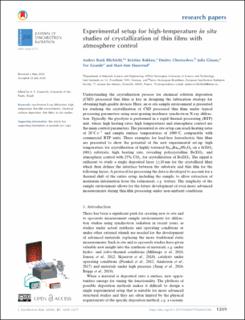| dc.contributor.author | Blichfeld, Anders Bank | |
| dc.contributor.author | Bakken, Kristine | |
| dc.contributor.author | Chernyshov, Dmitry | |
| dc.contributor.author | Glaum, Julia | |
| dc.contributor.author | Grande, Tor | |
| dc.contributor.author | Einarsrud, Mari-Ann | |
| dc.date.accessioned | 2021-03-29T08:30:33Z | |
| dc.date.available | 2021-03-29T08:30:33Z | |
| dc.date.created | 2020-09-04T10:49:57Z | |
| dc.date.issued | 2020 | |
| dc.identifier.citation | Journal of Synchrotron Radiation. 2020, 27 1209-1217. | en_US |
| dc.identifier.issn | 0909-0495 | |
| dc.identifier.uri | https://hdl.handle.net/11250/2735860 | |
| dc.description.abstract | Understanding the crystallization process for chemical solution deposition (CSD) processed thin films is key in designing the fabrication strategy for obtaining high-quality devices. Here, an in situ sample environment is presented for studying the crystallization of CSD processed thin films under typical processing parameters using near-grazing-incidence synchrotron X-ray diffraction. Typically, the pyrolysis is performed in a rapid thermal processing (RTP) unit, where high heating rates, high temperatures and atmosphere control are the main control parameters. The presented in situ setup can reach heating rates of 20°C s−1 and sample surface temperatures of 1000°C, comparable with commercial RTP units. Three examples for lead-free ferroelectric thin films are presented to show the potential of the new experimental set-up: high temperature, for crystallization of highly textured Sr0.4Ba0.6Nb2O6 on a SrTiO3 (001) substrate, high heating rate, revealing polycrystalline BaTiO3, and atmosphere control with 25% CO2, for crystallization of BaTiO3. The signal is sufficient to study a single deposited layer (≥10 nm for the crystallized film) which then defines the interface between the substrate and thin film for the following layers. A protocol for processing the data is developed to account for a thermal shift of the entire setup, including the sample, to allow extraction of maximum information from the refinement, e.g. texture. The simplicity of the sample environment allows for the future development of even more advanced measurements during thin-film processing under non-ambient conditions. | en_US |
| dc.language.iso | eng | en_US |
| dc.publisher | International Union of Crystallography | en_US |
| dc.relation.uri | https://doi.org/10.1107/S1600577520010140 | |
| dc.rights | Navngivelse 4.0 Internasjonal | * |
| dc.rights.uri | http://creativecommons.org/licenses/by/4.0/deed.no | * |
| dc.title | Experimental setup for high-temperature in situ studies of crystallization of thin films with atmosphere control | en_US |
| dc.type | Peer reviewed | en_US |
| dc.type | Journal article | en_US |
| dc.description.version | publishedVersion | en_US |
| dc.source.pagenumber | 1209-1217 | en_US |
| dc.source.volume | 27 | en_US |
| dc.source.journal | Journal of Synchrotron Radiation | en_US |
| dc.identifier.doi | 10.1107/S1600577520010140 | |
| dc.identifier.cristin | 1827315 | |
| dc.relation.project | Norges forskningsråd: 250403 | en_US |
| cristin.ispublished | true | |
| cristin.fulltext | original | |
| cristin.qualitycode | 1 | |

